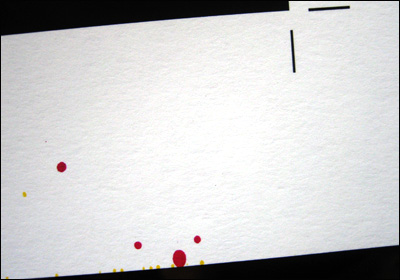Thu 3 Feb 2011
Gene Bunk
Posted by anaglyph under Hokum, In The News, Scary, Science, Skeptical Thinking, Technology, WooWoo
[31] Comments

Do you have your tin foil beanies on this morning Acowlytes? Have you supped well on your goji drinks, rubbed your ShooTag and cleansed your bowels thoroughly with colloidal silver? No? Well you might want to get used doing all those things and more, because that is certainly the future which awaits us if the current trend by some science magazines plays out to its inevitable conclusion.
The latest issue of New Scientist runs a cover article headlined ‘Ghost DNA; Nobelist claims he can ‘quantum teleport’ genes’. I can’t begin to convey to you how much this kind of half-baked pap passing as ‘science’ journalism pisses me off. ((This is the second of two New Scientist articles that have really gotten up my nose in recent months. The first was their uncritical reporting of the so-called statistical evidence for existence of precognition revealed in experiments conducted by ‘psi’ researcher Daryl Bem. The Bem work is so filled with problems as to be laughable, and has been subsequently comprehensively picked apart by scientists and statisticians alike. Experiments replicating those carried out by Bem have, predictably, not shown the same results he claimed to have found. But where is the New Scientist followup revealing all this? Not as headline-grabbing as ‘Evidence we can see the Future?’, I suppose.))
The story, in a nutshell, is that Luc Montagnier, a scientist previously awarded the Nobel prize for his work with AIDS, has published results of an experiment that he says shows that DNA can be remotely ‘imprinted’ in water. He further contests that the imprint can then be reconstituted into actual DNA via polymerase chain reaction (PCR). Writing it down like that makes it seem so patently stupid, that I had to go back and check that this was, in fact, what Montagnier claims. And yes, it is.
You can read the full process of Montagnier’s experiment here, if you can make sense of it. Essentially, Montagnier contests that when an electromagnetic field is applied to a flask of DNA, that field somehow picks up something from the DNA that can be somehow transmitted to an adjacent but isolated flask of purified water, somehow transferring something into the water. PCR is somehow able to amplify this something which results in actual real DNA being created in the previously-pristine flask. ((My initial response as a person with zero training in genetic chemistry was to want complete assurance that Montagnier’s experimental protocol had completely excluded the possibility of contamination. PCR experiments are notoriously prone to contamination problems. Occam’s Razor dictates here that, in the face of one experiment by one scientist who already holds partisan homeopathic views, the most likely explanation for Montagnier’s results is the actual explanation: that his ‘pristine’ flask was contaminated.)) As you can see, that’s more somehows and somethings than your average episode of Ghost Hunters.
Montagnier offers no mechanism that might allow DNA to be able to be recorded or transmitted electromagnetically in this manner, nor any method by which water might be able to receive this transmission and retain it. He also fails to offer any explanation of a process via which this ‘ghostly’ DNA could become corporeal DNA. Instead, his notes make reference to discredited homeopathy researcher Dr. Jacques Benveniste, and calls on the concept of ‘water memory’, a flimsy pseudoscientific notion that has resisted numerous attempts to give it any credence. All in all, there are so many hallmarks of fruit-loopery throughout Montagnier’s proposition that you really have to ask yourself why ANYONE is giving this ridiculous fluff the time of day. Well, of course, it is Montagnier’s Nobel credentials that are the angle here. He’s a Nobel laureate, so he has to be an all-round genius, right? Wrong. Having a Nobel prize doesn’t prevent you from being an idiot in some other area. New Scientist is indulging in a favourite tactic of woo-mongers: an appeal to authority. Montagnier’s controversial Nobel prize relates to work he did on HIV/AIDS. This does not make him an expert on everything. ((The New Scientist editorial attempts to evoke fairness by pointing this out. It’s a journalistic trick that truly annoys the crap out of me – stick in a bunch of reasonable objections to ‘show’ that you can see the logical flaws in your argument, but then go ahead and ignore what you just did by plastering ‘Nobel Prize Winner’ in the headline of your article. Scumbags.))
New Scientist’s editorial in defense of their decision to publish this information is the real killer, though. It is disingenuous and unctuous. They open with this:
As the old saying goes, it’s good to have an open mind but not so open that your brains fall out. This week we report claims about the way that DNA behaves that are so astonishing that many minds have already snapped shut.
Did you spot it? Yep, there’s New Scientist, a magazine that is supposedly offering proper science journalism, jumping on another defense beloved of practitioners of pseudoscience: ‘If you don’t immediately give credence to some outrageous claim, you have a closed mind’. New Scientist editors, double shame on you. ((And, I might add, making this statement in this context is a damn good illustration of exactly what you’re purporting to be declaiming with it – your ‘open’ mind is quite publicly leaking your brains all over the carpet.))
After a meandering attempt to appear like they’ve given the decision some thought, they arrive at their compelling reason for carrying the story:
We decided to go ahead because any bona fide experimental result is worthy of scrutiny, and the claims are nothing if not interesting.
No, let’s just have some honesty here. You decided to go ahead because this is the kind of thing that sells copies of your magazine. If you are pretending to any level of scientific credibility at all, you don’t just up and publish any old crap on the pretext that it has ‘interesting’ claims. If you were truly sincere about informing people of the science behind this story, you would have waited for some of the additional results from third party researchers that you admit are necessary for this experiment to have any validity. Of course, when that happens it will be a non-story (as I submit you are fully aware) and the headline ‘Scientists prove AGAIN that the concept of water memory is a crock of shit’ will not be nearly as lucrative on the news stand as some spurious one-liner involving ghosts, teleportation and ‘quantum’ magic. I further contest that if science was really your priority, you would have offered a little more depth on Luc Montagnier’s bona fides, including his predisposition towards believing in homeopathy (something you, yourselves have – quite hypocritically we must conclude – denounced previously as pseudoscience when it suited your headline).
I suggest that this quote from Luc Montagnier taken from an interview with Science magazine last month, might have added some context to his experiment:
I can’t say that homeopathy is right in everything. What I can say now is that the high dilutions (used in homeopathy) are right. High dilutions of something are not nothing. They are water structures which mimic the original molecules.
This shows us one thing very clearly: Luc Montagnier didn’t get his Nobel Prize for logical thinking. As is trivially easy to demonstrate, the high dilutions offered by homeopathy ARE, in many cases, nothing. After a certain level of dilution, a homeopathic substance is likely to contain not even one molecule of the original substance. What Montagnier wants us to believe, though, is that, by a mechanism that is pure speculation at best and has no basis in reality whatsoever, it’s not the molecules themselves that matter, but ‘something’ they leave behind. It’s crucial to understand that Montagnier is not building on any previous science ((All good science comes riding on the coattails of other science. In the 21st Century it is rare to the point of extraordinary for a major scientific discovery to pop out of nowhere.)) to assert this. It’s merely a magical belief. ((And it’s a belief that seems so simplistic and the counter-arguments so self-evident that I won’t even bother to tread that ground again. I’ll just point out once more that every glass of water you drink has ultra-diluted something in it. Pick anything: cyanide; sugar; apple juice; cow piss; snake venom. Whatever it is, its effects will be in operation in that water according to homeopathic ‘reasoning’. If you want to follow the ultimate absurdity of Montagnier’s experiment, you’re buying into a notion where you don’t have to even dilute the water in the first place – things can get ‘transmitted’ into the water from elsewhere! With all that dilution and transmission going on, there’s so much stuff in water that it’s a miracle it’s drinkable!))
All that being as it may, what Luc Montagnier is claiming to demonstrate with his experiment does not equate with claims of homeopathy anyway. ((Well, not with anything that homeopathy has claimed so far – I’m sure they’ll find a way to incorporate this new wonderful mechanism.)) Let me clarify: homeopaths contend that, by dissolving substances (whose efficacy is determined by nothing more than superstition) into extreme dilution in water they can achieve advantageous human health outcomes. The mechanism by which this is supposed to happen has no rational basis and can’t be scientifically shown to have any effect. But Montagnier’s experiment is (supposedly) demonstrating something else entirely: that he can transmit, via a process for which he has no explanation, something into water that wasn’t there in the first place and then reconstitute a biological product from it. He’s conflating a bizarre idea with an outlandish idea and then asserting that this makes BOTH ideas reasonable! What extraordinary nonsense.
New Scientist also neglects to mention that Montagnier’s Nobel Prize was the subject of prolonged antagonism, that (while Montagnier certainly contributed to the effort) the scientist who is actually now credited with demonstrating that the HIV virus causes AIDS was not Montagnier but Robert Gallo, and that one of the biggest issues in the controversy surrounding the Prize was sample contamination inside Montagnier’s lab – all factors that have bearing on the article at hand.
The magazine further tarnishes its image by including this spurious quote, as, geez, I dunno, some kind of ‘food for thought’ or something:
‘If the results are correct,’ says theoretical chemist Jeff Reimers of the University of Sydney, Australia, ‘these would be the most significant experiments performed in the past 90 years, demanding re-evaluation of the whole conceptual framework of modern chemistry.’
This kind of cheap sensationalism is breathtaking in its banality and has no place in a science journal. It’s a quote that means FUCK ALL. It’s a speculation that’s logically equivalent to saying ‘If pixies exist, we may never have to do the dishes ever again!’ It’s a NON quote. It’s vacuous journalism at its most pathetic.
Acowlytes. I’m sure you can feel my anger about this fairly radiating out of your computer screen. When a magazine like New Scientist runs an article lending plausibility to half-baked pseudoscientific concepts, they have an enormous detrimental effect on the already depressingly slow progress of critical thinking. We don’t need ‘scientists’ giving credence to every stupid idea that comes down the pike under the pretext of ‘it’s a valid experiment until the results prove otherwise’. The fact is that some ideas start out plain stupid, and never do anything more than traipse downhill into the vast bog land of Suck. It is the responsibility of periodicals like New Scientist, as purveyors of science news, to make decisions about framing a scientific world-view for their readers, not to encourage the flimsy philosophies and elliptical thought processes of those who espouse magical thinking by giving their silly ideas ‘scientific’ credibility.
What happens after an article like this appears is predictable and depressing. Searching the web for ‘luc montagnier’ in conjunction with ‘homeopathy’ delivers a flood of links to sites claiming that science has at last ((Or ‘again’, depending on how you look at it – homeopaths claim scientific endorsement of the stupid idea at the drop of a hat, and neglect ever to mention all those times when science has shown it to be a pile of horseshit.)) endorsed homeopathy. From the predictable brainless spew of Dana Ullman in the Huffington Post gushing that Luc Montagnier, Nobel Prize Winner, Takes Homeopathy Seriously, to the slack-jawed critical-thinking-free crowing of the various homeopathy advocates that Luc Montagnier Foundation Proves Homeopathy Works the woo-web is awash with brains-on-the-floor excitement.
For the sake of a salacious news stand headline, one dumb misstep by the Science press has all but undone the great work of skeptics over the last few years in demonstrating to the public just what a bunch of hokum homeopathy is.
Great work guys. And every year you run whiney op-ed pieces about how science funding is being slashed. In case you haven’t managed to figure it out, that’s the logical outcome of dumbing down the world.
UPDATE: More fuming! Because I’ve been away, I’m working my way through back issues of New Scientist that have accumulated in my absence. This used to be a pleasurable pursuit, but it’s turning out this time to be a lolly-grab of stupidity. Last night I read this editorial, in which we find NS criticizing NASA for hyping up the science behind the search for extraterrestrial life.
IT’S life, but not as we know it,” trumpeted one headline. “Alien life may have been discovered – right here on Earth,” gasped another. Even The New York Times declared “Microbe Finds Arsenic Tasty; Redefines Life”.
The breathless write-ups followed NASA’s teasing announcement of a news conference “that will impact the search for evidence of extraterrestrial life”. And although the discovery of alien life, if it ever happens, would be one of the biggest stories imaginable, this was light years from that.
Oooh. They wouldn’t be anything like headlines that scream ‘Ghost DNA; Nobelist claims he can ‘quantum teleport’ genes’ or ‘Evidence we can see the Future?’, would they now you fucking hypocrites?
The editorial concludes:
Perhaps it (NASA) thinks that all publicity is good publicity, but one day the appetite for sensationalist alien life stories may be sated.
At which point I suggest that New Scientist might like to start fishing around for the log in their own eye rather than looking for the mote in their neighbour’s.
















